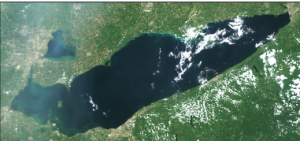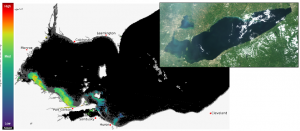Homepage Slider, Water Quality
Microcystis cyanobacteria bloom monitoring in western Lake Erie
Information from the National Centers for Coastal Ocean Science and National Oceanic and Atmospheric Administration
The National Oceanic and Atmospheric Administration (NOAA) provides forecasts for seasonal blooms of cyanobacteria (blue-green algae) in Lake Erie, typically from July to October when warmer water creates favorable bloom conditions. Western Lake Erie has been plagued by an increase of Hazardous Algal Blooms (HABs) intensity over the past decade. These blooms consist of cyanobacteria or blue-green algae, which are capable of producing toxins that pose a risk to human and animal health, foul coastlines, and impact communities and businesses that depend on the lake. A combination of satellite image (for bloom location and extent), a forecasting and mixing model provide information on the current status of the bloom, forecasted position both at the surface and at depth, and toxicity from field samples.
The Microcystis cyanobacteria bloom in western Lake Erie has an approximate area of 120 square miles, which is a decrease in area since Aug 04. The bloom continues near the Ohio coast from Maumee Bay past Huron. Highest concentrations and scum may be present west of Catawba Island. Traces of cyanobacteria are detectable in Sandusky Bay. This is unrelated to western Lake Erie blooms.
The seasonal forecast was issued June 30. No recent toxin data is currently available.
Current Lake Erie Sentinel-3A satellite imagery from the Ocean and Land Color Imager (OLCI) on Aug 05, 2021, showed bloom locations and the extent in the western basin. The estimated threshold of cyanobacteria detection is 20,000 cells/mL. Blooms mix through water column at wind speeds > 15 knots.